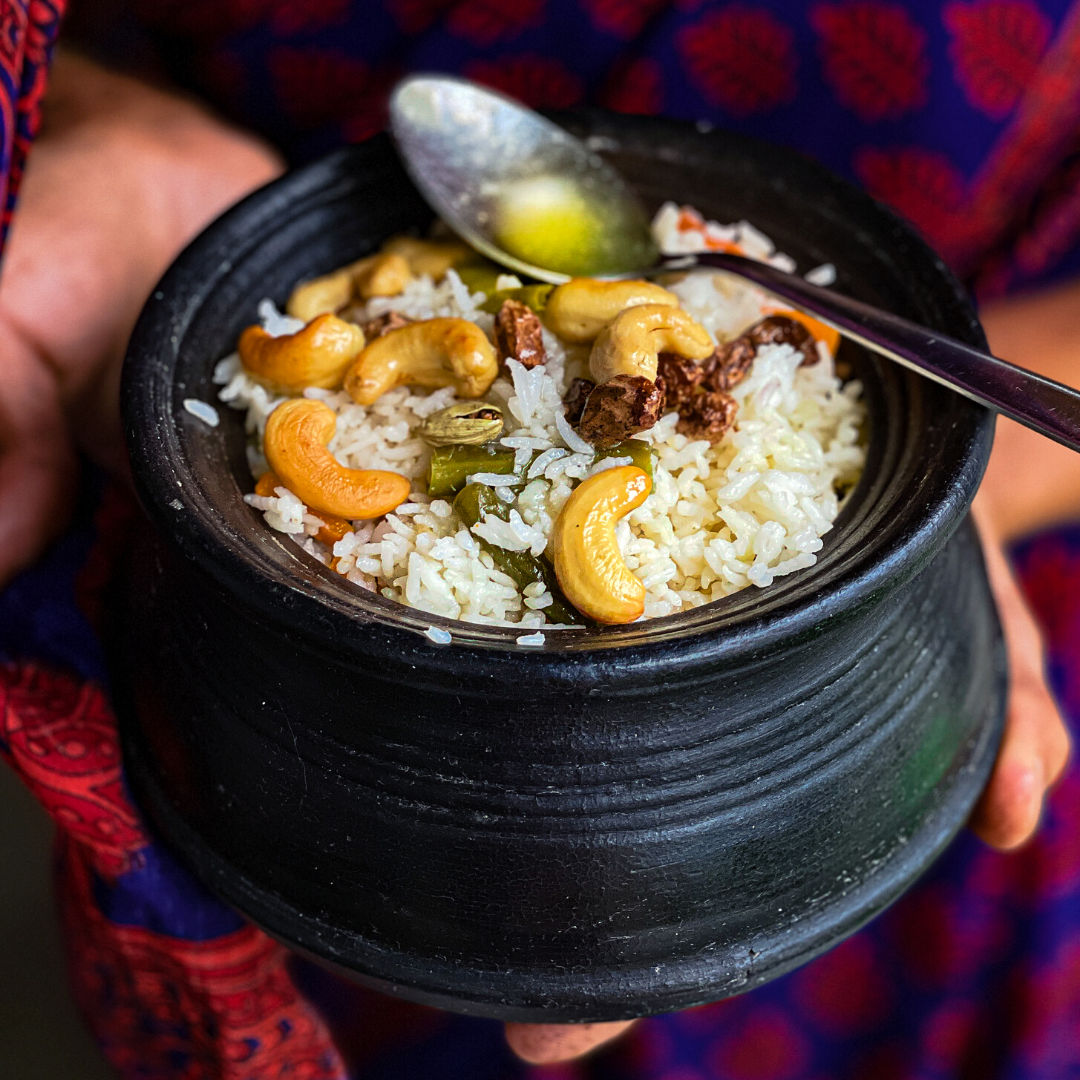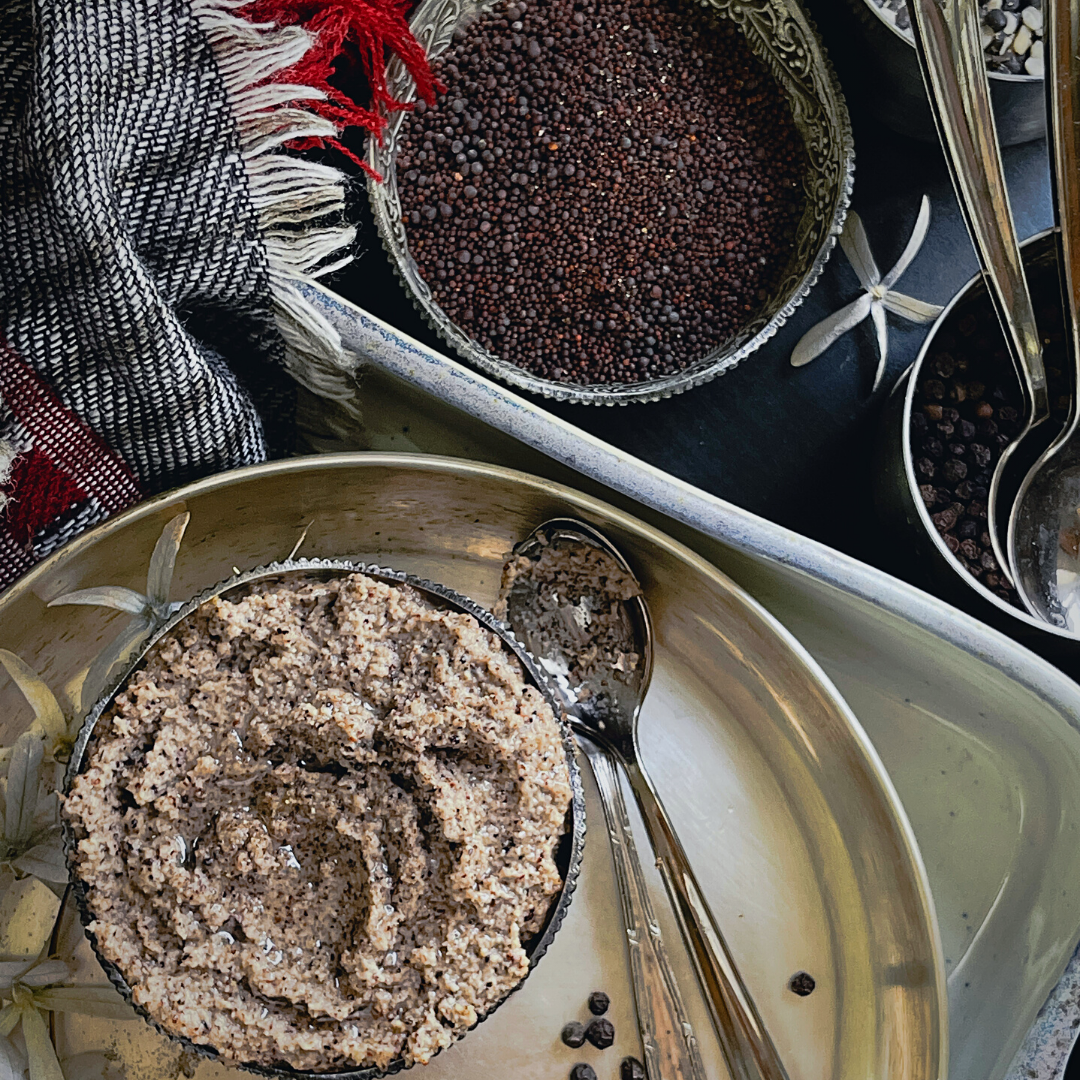This year we bring you a special series #NavaratriWithTBOF - one that is festive and colourful and a 'Culinary Celebration' of the colours of these 9 days of Navaratri! We will bring you ONE DELICIOUS RECIPE every day for these 9 days that will be all about the festive colour for that day.
In India we celebrate 9 forms of the Divine Mother through these 9 days and each day is assigned a colour each year.
#NavaratriWithTBOF - Day 4 Colour - Orange
Kushmanda - The fourth incarnation of Goddess Durga is Kushmanda. It is believed as her name suggests, that she with a fraction of her enchanting smile, created the entire universe. She is seen with her eight hands and the ‘Abhayamudra’ that blesses all her devotees with health, prosperity and happiness.
The colour Orange for this day is symbolic of her radiant smile, brilliance and warmth.
Today’s recipe is a mesmerizing tribute to the Goddess’ smile as her name suggests. The food of TamilNadu from where this particular ghee recipe has been sourced is full of flavour, light on the stomach and slightly elevated in terms of spice, a flaming fiery burst of flavour to do complete justice to the colour Orange!
Depending on each family’s palate, the chilli level could be adjusted between a mild medium to a tongue numbing heat. The gravy dishes from this belt are referred to as a ‘kulambu or kuzhambu’ as pronounced in the vernacular.
It comprises a blend of ingredients which make up the base masala paste. The cooking medium used here is a mix of native oils, cold pressed from ingredients grown locally and native cow ghee.
Sprouted Moong (green gram), Kulith (horse gram), red lobia etc are mixed, soaked and sprouted to make the Fiery ‘Navathaniyam Kulambu’ ( mixed sprouted gravy)
It is delicious when eaten with rice for lunch or as an accompaniment for the staple dinner tiffins with dosa or chapathis or idlis.
For the traditional recipe for the South Indian ‘Navathaniyam Kulambu’ sprouts gravy with desi ghee, head straight to the link in Bio.
Written by Shanthini Rajkumar
The Southern part of the Indian subcontinent is popularly referred to as South India. The States comprising Andhra Pradesh, Telangana, Karnataka, Kerala and Tamil Nadu do share similarities in the form of customs, traditions and food recipes. The languages spoken in these States are all unique and have their own individual script, much like the rest of India.
The home kitchens in the South were made up of rough stone floors, cool enough to work on during a hot summer day. The winter months are not very extreme so this part of the country is known for the hotter weather and the timely monsoons.
The food of Tamil Nadu from where this particular ghee recipe has been sourced is full of flavour, light on the stomach and slightly elevated in terms of spice. Depending on each family’s palate, the chilli level can be tweaked between a mild medium to a tongue numbing heat.
The gravy dishes from this belt are referred to as a 'kulambu' or 'kuzhambu' as pronounced in the vernacular. It comprises a blend of ingredients which make up the base masala paste. The cooking medium used here is a mix of native oils, cold pressed from ingredients grown locally and native cow ghee. Most homes in smaller cities and towns included cow sheds within the compounds. Fresh full fat milk , butter, buttermilk and ghee form an important part of the diet even today.
It was common to see large cauldrons being brought out to churn the buttermilk by hand. Delicious pats of butter would be lifted out from the thin white buttermilk and piled inside a container to be kept aside for making ghee.
It is the ghee that takes precedence in the recipes from Tamil kitchens, much more than the butter. Again that had to do with the climate which was often warm and pleasant but rarely cold (except in the hills) . This led to a diet low in butter but included generous amounts of ghee.
No paruppu sadam or idli with podi would be complete without a generous spoonful of ghee. It is what the elders swear by and have thankfully made a comeback into the regular diet today.
Most of the food cooked here on a week day is varied vegetarian fare if one follows the traditional Tamil food diet. Farming and seasonal agriculture continues to be an important occupation. The food that was eaten at lunchtime was designed with the intention of fortifying the body with vitamins and minerals as well as the much needed muscle building proteins. A vegetarian protein which is well liked and consumed often are pulses. Sprouted green gram, horse gram, red lobia etc are mixed, soaked and sprouted to form the Navathaniyam Kulambu ( mixed sprouted gravy)

It is delicious when eaten with rice for lunch or as an accompaniment for the staple tiffins of dinner (dosa, oothappam, idli etc)
A typical South Indian meal would contain a kuzhambu, 2 poriyals (stir fry) made of seasonal vegetables, a rasam , rice and curd. On certain days, there would be mashed greens or cooked lentils with a crunchy side in the form of a fried appalam. Simple, hearty and delicious.
The following is the traditional recipe for this south Indian sprouts gravy with desi ghee.
Recipe for Navathaniyam kuzhambu
Ingredients
Mixed sprouts - 2 C
Small onions -1/2 C chopped fine
Tomatoes - 3 chopped
Green chilies - 4 or to taste
Ginger garlic paste - 1 tsp
Coriander seeds - ½ tsp
Cumin seeds -½ tsp +1/4 tsp
Chana dal - 1 Tsp
Sesame seeds - ½ tsp
Fennel seeds - ½ tsp
Black peppercorns - ½ tsp
Freshly grated coconut - 2 Tbsp
Water for grinding
Tamarind -1 gooseberry size ball, soaked in 1/2C of warm water
Salt to taste
Ghee-2 Tbsps
Curry leaves - a few
Dried red chillies - 2-3
Salt to taste
Jeera powder - 1/2 tsp
Coriander powder - 1/2 tsp
Turmeric powder - 1/2 tsp
Red chilli powder - to taste
Gingelly oil - 3 Tbsp
Mustard seeds - 1/4 tsp
Method
Wash the sprouts thoroughly to ensure there is no fungus
Place it in a pot and cover with water. This can also be done in a pressure cooker.
If using a pressure cooker, cook for 2-3 whistles and let it cool.
If using an iron kadai or terracotta pot, let it boil for about 15 minutes.
Turn off the fire.
Make the masala paste
In another vessel, add the gingelly oil and put it on the stove on a low flame.
Add the chana dal, coriander seeds, 1/2tsp cumin seeds, peppercorns, sesame seeds and saute until lightly golden.
Transfer to the grinding stone or mixer jar.
In the same oil, turn the fire onto low again and add the chopped onions, ginger and garlic paste and saute’ until the onions are soft. Add the tomatoes and keep frying until it turns soft and pulpy. Add the turmeric powder, dania powder, jeera powder, red chilli powder and a little salt and mix well for a few seconds. Take off the fire and add to the other ingredients for grinding.
Add the fennel seeds and fresh coconut to the grinding stone or mixer jar.
Add a little water and grind it all together to a smooth paste.
Gravy
Squeeze the tamarind in the water and extract the thick pulp. Strain. (The waste pulp can be used to shine vessels)
Add the tamarind to the vessel with the cooked sprouts and let boil until the raw smell goes.
Add the ground masala paste and salt and mix well.
Let it boil for 6-8 minutes.
Taste and check seasoning. If necessary, you can add more salt or spice as required.
Once it has cooked down to the required consistency, take it off the flame.
Use a small kadai meant for tempering and add the ghee.
Place it on low heat.
Add the mustard seeds. When it crackles and pops , add the 1/4tsp cumin seeds, dried red chillies and curry leaves.
Turn off the flame when it splutters.
Pour it immediately over the sprouts gravy and let it mix.
Serve it hot or warm with plain rice or any other staple like chapati or idli.

When the pulses and legumes are made to sprout, it increases the nutritional value of the ingredients. Levels of Vitamin C, B and A present in these ingredients are enhanced.
The most important advantage however is in the digestion. Sprouting helps the proteins to be easily digested and assimilated which is especially beneficial for elders.
Contrary to the belief that raw foods are healthier than cooked foods, it is better to steam or boil sprouts before consuming.
Since pulses are made to sprout in a dark, covered space, it can also lead to the formation of fungus and other unhealthy bacteria. This is why it is recommended to cook sprouts first. This traditional gravy combines the benefits of native pulses, spices along with healthy foods like onion and garlic to give a well balanced meal both in taste and nutrition.
The kind of sprouts used can vary depending on personal preferences. Kabuli chana, peanuts, whole millets etc are also equally good options to make this dish.
A culinary visit to sample the heritage dishes of our country can lead to some amazing discoveries. Join us on this ghee path of unearthing simple recipes from Indian kitchens.










